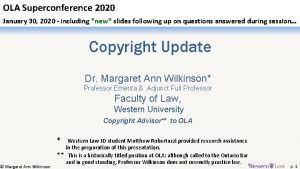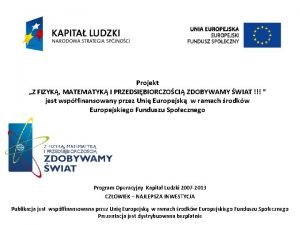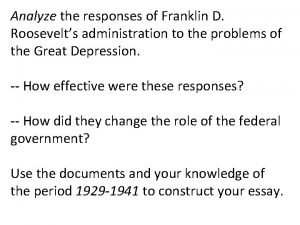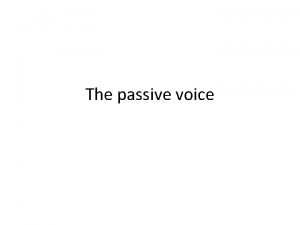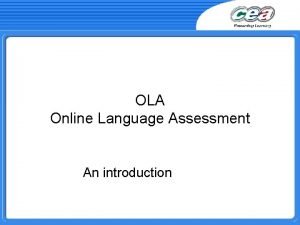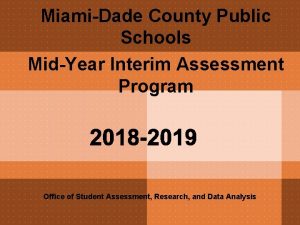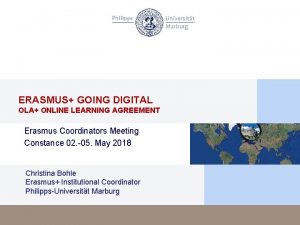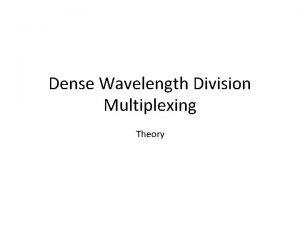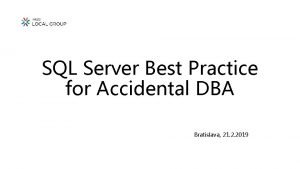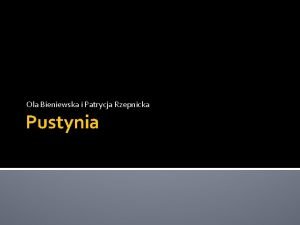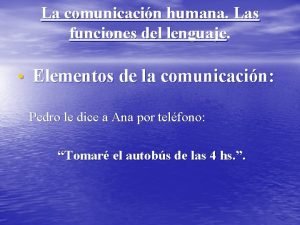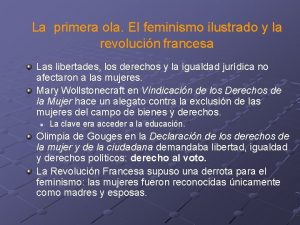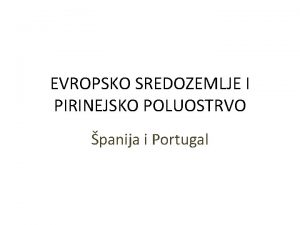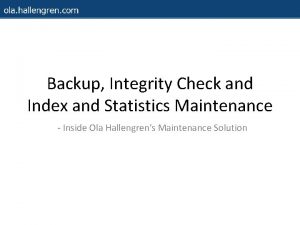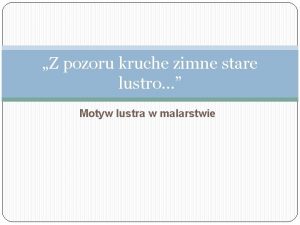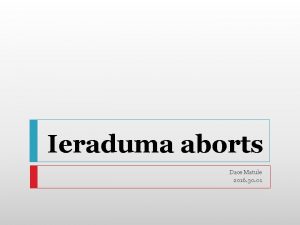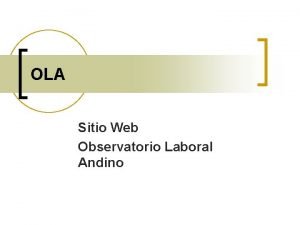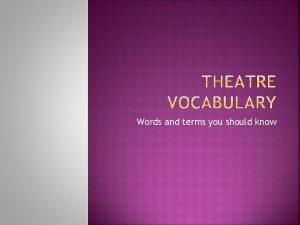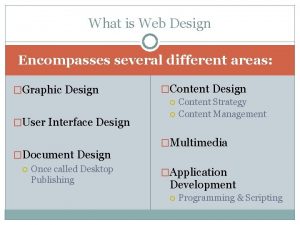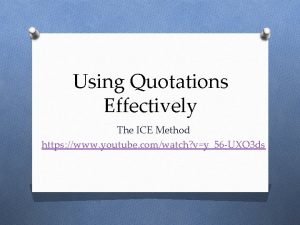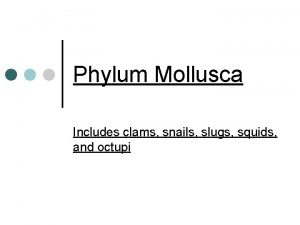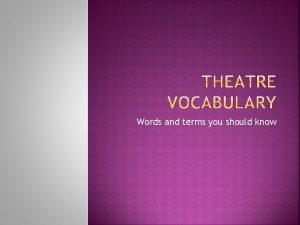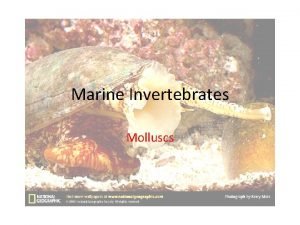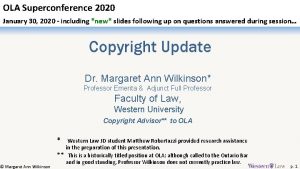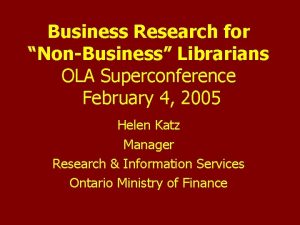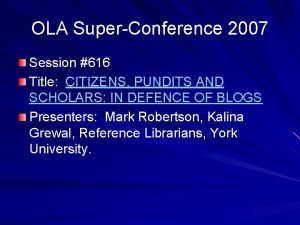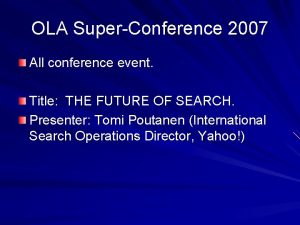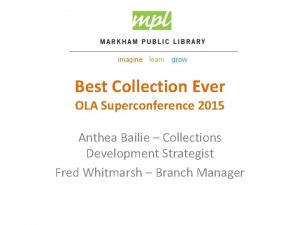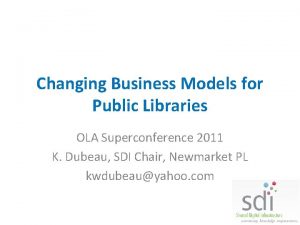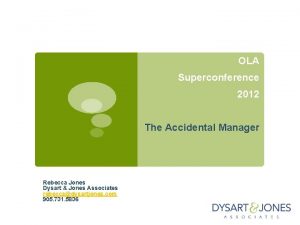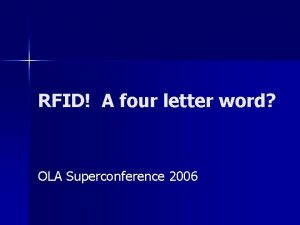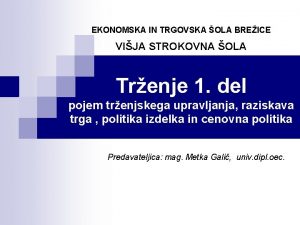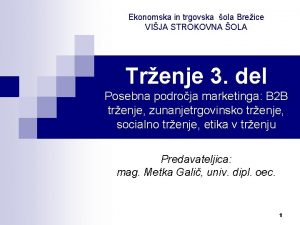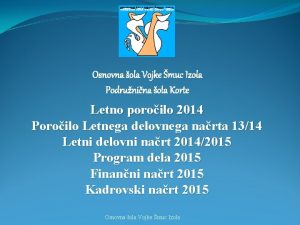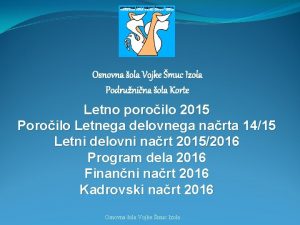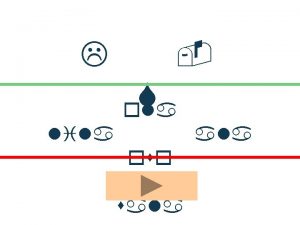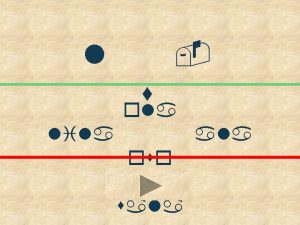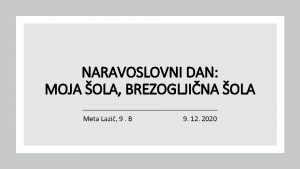OLA Superconference 2020 January 30 2020 including new




















































- Slides: 52

OLA Superconference 2020 January 30, 2020 – including *new* slides following up on questions answered during session… Copyright Update Dr. Margaret Ann Wilkinson* Professor Emerita & Adjunct Full Professor Faculty of Law, Western University Copyright Advisor** to OLA * Western Law JD student Matthew Robertazzi provided research assistance © Margaret Ann Wilkinson in the preparation of this presentation. ** This is a historically titled position at OLA: although called to the Ontario Bar and in good standing, Professor Wilkinson does not currently practice law. p. 1

Outline: A. Copyright and International Trade B. Copyright at the United Nations C. The Effect of “Brexit” D. Copyright Litigation Update E. Where are we on statutory reform of the Copyright Act? © Margaret Ann Wilkinson p. 2

Outline: A. Copyright and International Trade B. Copyright at the United Nations C. The Effect of “Brexit” D. Copyright Litigation Update E. Where are we on statutory reform of the Copyright Act? © Margaret Ann Wilkinson p. 3

A. Copyright and International Trade Agreements (in addition to 1994 TRIPS Agreement) now affecting Canada: i. Canada-European Union Comprehensive Economic and Trade Agreement (CETA) (2016) -- in force in Canada through the Canada-EU Comprehensive Economic and Trade Agreement Implementation Act, Statutes of Canada 2017, c 6 - NO change required to Canada’s copyright law. ii. Comprehensive and Progressive Agreement for Trans-Pacific Partnership (CPTPP) (2018) -- in force in Canada through the Comprehensive and Progressive Agreement for Trans-Pacific Partnership Implementation Act, Statutes of Canada 2018, c. 23 –US not a party; NO change required to Canada’s copyright law. iii. Canada-United States-Mexico Agreement (CUSMA) (December 10, 2019); CHANGE required. © Margaret Ann Wilkinson p. 4

The 2019 CUSMA/ACEUM/T-MEX/USMCA will replace NAFTA We noted last year, in our 2019 Copyright Update, that a deal [USMCA] was reached between the US, Canada and Mexico on Sept. 30, 2018 and signed by the three countries on Nov. 30, 2018… HOWEVER on December 10, 2019 amendments to that 2018 agreement were signed by all three countries… (but are not yet in force)… • • Mexico ratified the agreement in December 2019 … • Government sitting as the new 43 rd Parliament (following the 2019 election) since December 5, 2019 but adjourned on December 13 th and only resumed sitting this week (January 27, 2020) – so Canada is not yet in a position to have completed its process… Bill C-4 tabled in Parliament yesterday (Jan 29, 2020) – see more in slides following… Both the American House of Representatives and Senate have passed the legislation necessary to ratify the trade deal – and President Trump is poised to complete the process with his signature… There are now four official names for the treaty: • Tratado entre Mexico, Estados Unidos y Canada (in Mexico): T-MEC • United States Mexico Canada Agreement (in the United States): USMCA • Canada United States Mexico Agreement (in Canada, in English): CUSMA • Accord Canada -- Etats-Unis – Mexique (in Canada, in French): ACEUM © Margaret Ann Wilkinson p. 5

Many Intellectual Property provisions of the 2018 deal survive in the 2019 deal (although the section numbers have changed): Chapter 20 governs Intellectual Property, including copyright…and the US refused to agree to any statement that copyright represented a balance between authors and users! • Footnote 61 states Article 20. 65 concerning “contractual transfers” does not affect the exercise of moral rights. • With respect to both TPMs and RMI, Canada can create exceptions from criminal procedures and penalties for those that are “a non-profit library, archive [including non -profit museum], educational institution” (see, on TPMs, Art 20. 66(4)(g) and, on RMI, Art 20. 67 (3). • Annex 20 -B to section J of Chapter 20 (on Intellectual Property) makes it clear that Canada can keep its “notice-and-notice” regime. • Art 20. 88 (1)(b) requires all three countries to shelter ISPs from financial liability in situations where “copyright infringements that they do not control or initiate or direct” take place through their networks. © Margaret Ann Wilkinson p. 6

Advantages were gained by Canada in terms of changes affecting Intellectual Property made in the “new NAFTA” between the 2018 and 2019 versions… For 2019 version: https: //ustr. gov/sites/default/files/agreements/FTA/USMCA/Text/20 -Intellectual-Property-Rights. pdf • Certain 2018 changes in patent and pharmaceuticals law now need not be made by Canada: AND – No requirement for 10 years data protection for biologics now – No requirement of availability of patents for new uses, new methods or new processes of using a known product) now – No requirement of data protection for new indications of existing drugs now • The state to state dispute resolution mechanisms (Chapter 31) cannot be blocked (as previously happened under NAFTA) by unilateral action of one state [the US failed to name people to resolve the disputes and thus frustrated the dispute resolution mechanisms]… …BUT © Margaret Ann Wilkinson p. 7

Not much gain made (from the perspective of librarians) was made between 2018 and 2019 with respect to copyright… Art 20. 62 (new section number, still in Section H: Copyright and Related Rights) still requires Canada to move to “life + 70” [no change for the US, which has “life + 70, ” or Mexico, which has “life + 100”] Period of copyright protection will be “life + 70” -- and where there is no “life”: – 75 years from the end of the year of authorized publication or fixation or, – if there is no fixation within 25 years, not less than 70 years from the end of the year of creation of the work, performance or phonogram… Slight advantage to the 2019 agreement: If the original September 30, 2018 agreement had come into force, Canada would have had to make the change as early as spring 2021; now Canada will not have to make the change until at least after July 2022 (2 ½ years after CUSMA comes into force; see now Art. 20. 89 (4(c))) © Margaret Ann Wilkinson p. 8

Outline: A. Copyright and International Trade B. Copyright at the United Nations C. The Effect of “Brexit” D. Copyright Litigation Update E. Where are we on statutory reform of the Copyright Act? © Margaret Ann Wilkinson p. 9

B. Copyright at the United Nations a) Marrakesh Treaty… For … Blind, Visually Impaired or Otherwise Print Disabled (Marrakesh VIP Treaty) b) Efforts at WIPO’s Subcommittee on Copyright and Related Rights toward a Treaty on Limitations for Libraries and Archives c) On the other hand, progress on limitations and exceptions for non-profit libraries on the trade side… © Margaret Ann Wilkinson p. 10

a) Marrakesh VIP Treaty https: //www. wipo. int/marrakesh_treaty/en/ • Two years ago, the European Union ratified the Treaty (October 2018), bringing 28 countries with its signing, and bringing Marrakesh into force in the EU January 1, 2019. • From just over 70 countries covered by Marrakesh as at last year’s OLA Copyright Update 2019, there are currently 89 countries covered by Marrakesh (though more have signed it but not yet ratified it) • The United Kingdom is leaving the EU tomorrow, reducing the number of countries covered by one, to 88, BUT the UK signed Marrakesh on its own on June 28, 2013 and now needs only to ratify it to bring the number of active Marrakesh participants up to 89 again! • Associated with the Marrakesh Treaty is the ABC Accessible Books Consortium (ABC), a public private partnership organization led by WIPO (the UN’s World Intellectual Property Organization) that is facilitating the exchange of accessible materials between countries. https: //www. accessiblebooksconsortium. org/portal/en/index. html • Last year we noted that there were only 415, 000 titles accessible through ABC and that this represented less than 10% of all published material… This year ABC is reporting 540, 000 titles accessible – a 30% increase over last year’s total © Margaret Ann Wilkinson p. 11

b) WIPO’s SCCR on Limitations for Libraries • The prospect of a UN Treaty dealing with limitations and exceptions to copyright for Libraries, Archives and Museums (“TLAM”), after more than a decade of effort, remains an active part of the United Nation’s agenda • While little progress has been made in the formal process of treaty-making… – There were two meetings of the World Intellectual Property Organization (WIPO) Sub-Committee on Copyright and Related Rights (SCCR) last year (the 38 th and 39 th) and before the 39 th meeting (October 2019) there was an entire two-day conference devoted to consideration of “TLAM”. • See the report on the conference prepared by the International Federation of Libraries and Associations (IFLA) here: https: //ifla. org/files/assets/hq/topics/exceptions-limitations/documents/wipo_international_conference. pdf – The next (40 th) SCCR will be held in Geneva June 29 -July 3, 2020. © Margaret Ann Wilkinson p. 12

c) On the other hand, progress is being made on limitations and exceptions for non-profit libraries on the trade side… Although progress is slow through the UN, on the trade side, with the 2019 CUSMA/ACEUM/TMEC/USMCA signed (as we have just discussed), the whole of North America is heading into a trade commitment that recognizes principles of limitations and exceptions related to copyright matters for libraries, archives, educational institutions and (for the most part) museums that are non-profit: • Art 20. 66 (1): provides criminal procedures and penalties for TPM circumvention shall be applied by member countries except against non-profit libraries, archives, museums, or educational institutions. • Art 20. 66(4)(g): with respect to TPMs, limitations and exceptions can include access by nonprofit libraries, archives or educational institutions for making acquisition decisions; • Art 20. 67 (3): related to RMI, countries need not create criminal provisions against non-profit libraries, museums, archives or educational institutions; • Art 20. 81 (18(b)) relating to Civil & Administrative Procedures & Remedies with respect to both TPMs and RMI, countries can provide that no damages will be available in civil proceedings against non-profit libraries, archives, or educational institutions. © Margaret Ann Wilkinson p. 13

Outline: A. Copyright and International Trade B. Copyright at the United Nations C. The Effect of “Brexit” D. Copyright Litigation Update E. Where are we on statutory reform of the Copyright Act? © Margaret Ann Wilkinson p. 14

C. The Effect of “Brexit” TOMORROW January 31, 2020! On the United Kingdom’s own law: • The copyright law of the European Union is becoming more and more restrictive in terms of permitted statutory users’ rights allowed in the domestic copyright laws of its member states: member states must implement the EU’s reforms by 7 June 2021. – Controversy has surrounded especially Article 13 of the EU reform which requires member states of the EU to make it relatively difficult to upload copyrighted works to “online content sharing services” such as Facebook and You. Tube (although there are exceptions permitted to be made “for purposes of quotation, criticism, review, caricature, parody and pastiche”) • The United Kingdom has already announced that it will not implement the copyright law of the European Union post-Brexit: – see BBC News, “Article 13: UK will not implement EU copyright law, ” 24 January 2020 © Margaret Ann Wilkinson p. 15

C. The Effect of “Brexit” (cont’d) In International Trade: • From tomorrow, the UK is no longer in a trade agreement (other than TRIPS) with Canada (UK signed TRIPS Jan 1, 1995); • Specifically, from tomorrow, the UK is no longer part of Canada-European Union Comprehensive Economic and Trade Agreement (CETA) (2016) • The UK and Canada are free to enter into any trade agreement involving copyright that the two countries see fit to join… © Margaret Ann Wilkinson On Copyright at the United Nations: • At WIPO – and, in particular, at the SCCR, the UK will not be part of the “EU block” – and, like Canada, will vote on its own as an independent sovereign nation… p. 16

Outline: A. Copyright and International Trade B. Copyright at the United Nations C. The Effect of “Brexit” D. Copyright Litigation Update E. Where are we on statutory reform of the Copyright Act? © Margaret Ann Wilkinson p. 17

D. Copyright Litigation Update 1. York University v Access Copyright, FCA # A-259 -17 2. Province of Alberta et al v Access Copyright, FC # T-326 -18 3. Sullivan v Northwood Media Inc, 2019 ONSC 9 (Master Short) 4. Pourshian v Walt Disney Company, 2019 ONSC 5916 (Master Graham) 5. Keatley Surveying Ltd v Teranet Inc, 2019 SCC 43 6. On the tariff front… © Margaret Ann Wilkinson p. 18

1. York University v Access Copyright before the Federal Court of Appeal: Case # A-259 -17; appeal heard March 5, 2019; judgment still reserved York appealed the decision of Justice Phelan (2017 FC 669) on a number of grounds: • Substantive: – that Justice Phelan erred in his treatment of fair dealing; AND – that Justice Phelan erred in his findings respecting the Interim Tariff • Procedural: – that the “bifurcation” of the trial (for which, it may be recalled, York had applied) did not proceed fairly and Justice Phelan’s judgment should be overturned on those grounds. The Federal Court of Appeal permitted the following intervenors to participate: • • Canadian Association of University Teachers [CAUT] / Canadian Federation of Students [CFS] Copyright Consortium of the Council of Ministers of Education, Canada Canadian Publishers/Publishers’ Council/Writers Union coalition Universities Canada (written submissions only) © Margaret Ann Wilkinson p. 19

As discussed at last year’s Copyright Update, whatever the outcome of the appeal, absent a settlement, the final outcome of the lawsuit is still years away… • 1 st, it seems inevitable that, whatever the outcome at the Federal Court of Appeal, there will be an appeal to the Supreme Court of Canada – and • 2 nd, Justice Phelan, whose July 12, 2017 judgment is under appeal in the Federal Court of Appeal, pointed out that judgment relates only to “Phase I” of the York lawsuit! – Recall, again, that on July 30, 2014, Prothonotary Aalto, at York’s instigation, made an Order in the lawsuit, for “bifurcation” of the trial into two phases – In his July 12, 2017 judgment on “Phase I” (now under appeal) Justice Phelan held that only in the future “Phase II” of the trial, the “damages phase” (see para 219), will York be able to raise fair dealing (see para 220)… © Margaret Ann Wilkinson p. 20

D. Copyright Litigation Update 1. York University v Access Copyright, FCA # A-259 -17 2. Province of Alberta et al v Access Copyright, FC # T-326 -18 3. Sullivan v Northwood Media Inc, 2019 ONSC 9 (Master Short) 4. Pourshian v Walt Disney Company, 2019 ONSC 5916 (Master Graham) 5. Keatley Surveying Ltd v Teranet Inc, 2019 SCC 43 6. On the tariff front… © Margaret Ann Wilkinson p. 21

2. Province of Alberta et al v Access Copyright, Federal Court # T-326 -18 • This is an ongoing lawsuit, initiated February 2, 2018, in the Federal Court, by the School Boards of Ontario and Ministries of Education for all Canadian Provinces (except BC and Quebec)… • An entirely separate legal proceeding from the ongoing York University v Access Copyright litigation (in which, as discussed, we await the decision of the Federal Court of Appeal) and the older Alberta (Education) v Access Copyright 2012 SCC 37. • In this lawsuit, the plaintiff education entities claim they overpaid Access Copyright, for the years 2010 -2012, by $25 million, payments ostensibly made for access to copyrighted materials but made for actual copying that should have been free. • Access Copyright is both defending itself and also has launched a counterclaim against the plaintiffs for $50 million in royalties it alleges were not paid to it by the education entities between 2013 and 2019 (amounts it claims are increasing by $8 million per year going forward) © Margaret Ann Wilkinson p. 22

Province of Alberta et al v Access Copyright (cont’d) • This lawsuit appears to be very far from going to trial… • Our OLA Copyright Update 2019 did not discuss this lawsuit because, although it was launched in 2018, it was embroiled in procedural matters being handled as part of the Federal Court’s “trial management process” for much of 2018… • In December 2018, a motion was brought by the plaintiff education entities to stay this case until the decision of the Federal Court of Appeal in the York University v Access Copyright matter (we have just discussed) was released… • On March 14, 2019 the motion was denied (by Prothonotary Mandy Aylen; see document 29 in the court record of proceedings) and thus the lawsuit will continue independent of, though in parallel with, the ongoing York University v Access Copyright litigation… © Margaret Ann Wilkinson p. 23

Province of Alberta et al v Access Copyright (cont’d) • This Province of Alberta et al v Access Copyright lawsuit has become a priority for many librarians this year because of a procedural order that has been made pursuant to it: • Certain schools are to provide evidence of their copying, as ordered by Prothonotary Aylen on June 13, 2019 (in document 31 in the court record of proceedings)… – See, for example, “ 9 N. L. schools randomly chosen to go over copyright records tied to legal spat” CBC Dec. 2, 2019 https: //www. cbc. ca/news/canada/newfoundland-labrador/schools-closed-copyright-court-order-1. 5380700 – And, “Whitehorse school among 300 required to turn in teaching plans as part of copyright lawsuit: teachers across Canada have been ordered to provide 7 years of teaching materials” CBC Jan. 20, 2020 https: //www. cbc. ca/news/canada/north/fh-Collins-copyright-lawsuit-1. 5421142 © Margaret Ann Wilkinson p. 24

D. Copyright Litigation Update 1. York University v Access Copyright, FCA # A-259 -17 2. Province of Alberta et al v Access Copyright, FC # T-326 -18 3. Sullivan v Northwood Media Inc, 2019 ONSC 9 (Master Short) 4. Pourshian v Walt Disney Company, 2019 ONSC 5916 (Master Graham) 5. Keatley Surveying Ltd v Teranet Inc, 2019 SCC 43 6. On the tariff front… © Margaret Ann Wilkinson p. 25

3. Sullivan v Northwood Media Inc, 2019 ONSC 9 (Master Short) • LM Montgomery, author of Anne of Green Gables & 22 more novels, died in 1942 – copyright in her entire corpus of works expired 50 years later, in 1992. • The television series “Anne” premiered on CBC (and later on Netflix) on March 19, 2017; in its 2 nd season, it was called “Anne with an E”; its 3 rd and final season was in the fall of 2019. • In the new “Anne/Anne with an E” series, Kevin Sullivan and Sullivan Entertainment sued Northwood Media (connected with Anne/Anne with an E” through one of its Executive Producers and writers) for copyright infringement of elements of the Sullivan movies “Anne of Green Gables” (1985) and “Anne of Avonlea” (1987) [included among those works referred to by Master Short as the “Sullivan Works”]. • In Sullivan v Northwood Media Inc. , the plaintiffs alleged Northwood Media breached, not any copyright ever held by Montgomery but more recently created copyright interests held by Sullivan and, as Master Short said (para 5), “conceivable damages, in the millions of dollars, are potentially at stake. ” • Master Short’s decision on the interlocutory motion before him dealt only with early stages of the lawsuit and was issued on July 19, 2019. There have been, to date, no further reported proceedings connected with this lawsuit. • The cancellation of “Anne with an E” after its 3 rd season was announced November 25, 2019. © Margaret Ann Wilkinson p. 26

In his decision on the preliminary matter, Master Short described the allegations made by Sullivan in the overall lawsuit (paragraph numbers are taken from Master Short’s judgment): [3] The plaintiff asserts that numerous elements contained in their bringing the original story and newly created stories involving both the characters of the original books and those subsequently created by or on behalf of plaintiffs (the “Sullivan Works”), have been appropriated by the defendants for a new television/Netflix version entitled “ANNE” or now “ANNE with an E” [4] The nature of the overall dispute is typified in these extracts (from a paragraph in the Statement of Claim) regarding the Defendants’ production: “The Premiere of “Anne” contains infringements of the original distinctive aspects of Sullivan’s Works, including: a) copying the decision to set the story in the late 1890’s as in Anne 1 and Anne 4, instead of being set in the 1870’s as in the Anne of Green Gables novel; b) copying the use of steam trains from a scene in Anne 3, not available in the 1870’s; c) copying the set and depiction of Charlottetown from Anne 4; d) copying the opening sequence of scenes from Anne 1 during which Anne’s life of hardship and emotional abuse at the hands of the Hammond family is depicted before being sent to the Hopeton Orphanage and ultimately to Green Gables, including copying the staging and story sequence wherein Matthew passes by Mrs. Lynde’s house on his way to the train station to pick up Anne; … [in the original] © Margaret Ann Wilkinson (xii) Anne offering up to Marilla that she is good at washing dishes from Anne 4. p. 27

D. Copyright Litigation Update 1. York University v Access Copyright, FCA # A-259 -17 2. Province of Alberta et al v Access Copyright, FC # T-326 -18 3. Sullivan v Northwood Media Inc, 2019 ONSC 9 (Master Short) 4. Pourshian v Walt Disney Company, 2019 ONSC 5916 (Master Graham) 5. Keatley Surveying Ltd v Teranet Inc, 2019 SCC 43 6. On the tariff front… © Margaret Ann Wilkinson p. 28

4. Pourshian v Walt Disney Company, 2019 ONSC 5916 (Master Graham) • Damon Pourshian, in high school in 1998, conceived of a film where the protagonist’s organs became personified characters guiding his behaviour; in 2000 at Sheridan College, Pourshain wrote a screenplay and oversaw production of a short film, called Inside Out. • INSIDE OUT is a feature-length Pixar (Walt Disney) animation released in 2015. [Note: Master Graham first adopted the device of showing Pourshian’s work as Inside Out and Pixar’s as INSIDE OUT. ] • Pourshian sued 9 companies, all incorporated in American states, under Canada’s Copyright Act, in Ontario’s Superior Court of Justice, for copyright infringement. The defendant companies moved to have themselves declared to be outside the jurisdiction of the Ontario Superior Court. • To decide on the motion, Master Short asked himself whether each defendant had a “real and substantial connection” to Canada. – The Defendants acknowledged that the claim against Disney Shopping Inc (that it is alleged to have distributed or sold merchandise related to the Pixar INSIDE OUT in Ontario) could proceed and Master Short so ordered [para 4] – He also found that Pixar and Walt Disney Pictures produced INSIDE OUT, in part, for the purpose of carrying on business in Ontario and the release of INSIDE OUT by Walt Disney Pictures for distribution in theatres in Canada “create[s] a good arguable case of a real and substantial connection between the claims against those defendants and Ontario” [para 42] – The action was stayed (that is, discontinued) against all the other six defendants … © Margaret Ann Wilkinson p. 29

Against Disney Shopping Inc, Pixar and Walt Disney Pictures we may expect this litigation to continue. © Margaret Ann Wilkinson p. 30

D. Copyright Litigation Update 1. York University v Access Copyright, FCA # A-259 -17 2. Province of Alberta et al v Access Copyright, FC # T-326 -18 3. Sullivan v Northwood Media Inc, 2019 ONSC 9 (Master Short) 4. Pourshian v Walt Disney Company, 2019 ONSC 5916 (Master Graham) 5. Keatley Surveying Ltd v Teranet Inc, 2019 SCC 43 6. On the tariff front… © Margaret Ann Wilkinson p. 31

Keatley Surveying Ltd. v Teranet 2019 SCC 43 - Teranet is a for-profit company that manages Ontario’s electronic land registry system; fees for use of Teranet are set by the Ontario government by statute. Keatley is the surveyor who was the named plaintiff representing all Ontario land surveyors who have prepared the surveys required to be included in Teranet’s position: by virtue of the Copyright Act, s 12, copyright vested in the Ontario Crown and surveyors therefore had no rights in connection with administration of the provincial land registry system managed by Teranet. • May 6, 2016 Ontario Superior Court: Justice Belobaba – Teranet prevailed. • Sept 28, 2017 Ontario Court of Appeal: Justice Doherty (for himself & Justices Brown and Miller) – Teranet prevailed. • Nov 27, 2017 Supreme Court granted leave to appeal; March 29, 2019, appeal heard by 7 person court: Chief Justice Wagner and Justices Abella, Moldaver, Karakatsanis, Côté, Brown, Martin • September 26, 2019 Unanimous decision but 2 separate sets of reasons released -- Teranet prevailed. – Copyright in the surveys is, by the Copyright Act, s. 12, vested in the Ontario Crown • Majority reasons: Justice Abella (Moldaver, Karakatsanis, Martin agreed) • Concurring but different reasoning: Justices Côté and Brown (Wagner, CJ, agreed) © Margaret Ann Wilkinson p. 32

Intervenors in the Supreme Court proceeding (5 government entities, 6 associations & centres, and 1 individual in 10 interventions) 1. Attorney General Ontario 2. Attorney General Canada 3. Attorney General British Columbia 4. Attorney General Saskatchewan 5. Land Title and Surveys Authority of British Columbia 6. Canadian Association of Law Libraries (CALL) 7. (a) Canadian Legal Information Institute, joint with (b) Federation of Law Societies 8. Samuelson-Glushko Canadian Internet Policy and Public Interest Clinic (CIPPIC) 9. (a) Centre for Intellectual Property, joint with (b) [Professor] Ariel Katz (U of T Law) 10. Canadian Standards Association © Margaret Ann Wilkinson p. 33

“Where copyright belongs to Her Majesty” s. 12 Without prejudice to any rights or privileges of the Crown, where any work is, or has been, prepared or published by or under the direction or control of Her Majesty or any government department, the copyright in the work shall, subject to any agreement with the author, belong to Her Majesty and in that case shall continue for the remainder of the calendar year of first publication of the work and for a period of fifty years following the end of that calendar year. • Virtually unchanged since Canada’s 1 st independent Copyright Act, once fully emancipated from Britain, was passed in 1921 – See SC 1921, c 24, s 10; closely modeled on the British 1911 statute provision • The majority in Keatley pointed out [para 90]: “This provision is a century old… this is the first time this Court has reviewed its scope… Parliament is of course free to consider updating the provision in its current review as it sees fit. ” © Margaret Ann Wilkinson p. 34

The test proposed by the minority is more straightforward (easier) than that applied by the majority: • • MINORITY: “Once a court is satisfied that a work was ‘prepared or published by or under direction or control’ of the Crown, it must then consider whether, at the time of preparation of publication, the work is a ‘government work’. This entails examining the character and purpose of the work. The work will be a ‘government work’ where the work serves a public purpose and Crown copyright furthers the fulfillment of that purposes [sic]. These will be works in which the government has an important interest concerning their accuracy, integrity and dissemination. ” [para 127] MAJORITY: requires an examination into whether the degree of the Crown’s direction and control over the 1. preparation or 2. publication of the work is sufficient to vest copyright in the Crown: 1. Prepared by the Crown when employee or independent contractor brings work into existence for or on behalf of Crown in course of employment or Crown dictates whether and how work will be made [paraphrased from paras 64 -67] 2. Work only published by Crown when the Crown exercises direction or control over the publication process including both a. the person publishing work, b. the nature, form and content of the final, published version of a work [paraphrasing para 67] • Factors to consider: (1) presence of statutory scheme transferring property rights in the works to Crown, (2) Crown physically possessing the work, (3) government having exclusive control to modify, ” (4) the “opt-in” nature of the statutory scheme, (5) the necessity of the Crown making the works available to the public. ” [para 69] © Margaret Ann Wilkinson p. 35

D. Copyright Litigation Update 1. York University v Access Copyright, FCA # A-259 -17 2. Province of Alberta et al v Access Copyright, FC # T-326 -18 3. Sullivan v Northwood Media Inc, 2019 ONSC 9 (Master Short) 4. Pourshian v Walt Disney Company, 2019 ONSC 5916 (Master Graham) 5. Keatley Surveying Ltd v Teranet Inc, 2019 SCC 43 6. On the tariff front… © Margaret Ann Wilkinson p. 36

Despite ongoing litigation before the Courts involving various tariffs, the Copyright Board continues with related tariff proceedings… *NEW SLIDE* On December 6, 2019 the Board issued its DECISION on the Access Copyright Tariffs for Post-Secondary Educational Institutions, 2011 -2014 and 2015 -2017, published in the Canada Gazette, Pt I, vol 153, no 49 Dec 7, 2019, with corrections to it (involving certain interest calculations) made and published in the Canada Gazette, Pt 1, vol 153, no 52 Dec 28, 2019. In its related REASONS, published December 6, 2019, the Board (although it acknowledged the issue had been raised during the proceedings) explicitly declined to opine “on whether compliance with a tariff is mandatory for users who do not seek to benefit from the license offered thereby. We are aware that related issues have been raised in recent judicial proceedings [citing the trial decision (2017 FC 699) in the York University v Access Copyright appeal (FCA # A-259 -17) discussed infra, in the previous slides] and it is not necessary for us to opine on the issue at this point. ” (para. 357; see https: //cb-cda. gc. ca/decisions/2019/Dec-2019 -SAT 06122019. pdf) © Margaret Ann Wilkinson p. 37

In the Tariff described on the previous slide, the Board made an unusual request for participation: *NEW SLIDE* To the extent it might be appropriate for a tariff to include wording whereby its benefits and obligations would only apply on an opt-in basis, we would appreciate a more complete record before including such a provision, and invite affected persons to participate in the proceedings on the next occasion the Board considers proposed tariffs for these users. [para 358] Three tariffs newly filed at the Board in 2019 may be particularly relevant to librarians as providing possible opportunities for “affected persons” to participate: • Access Copyright Elementary and Secondary Schools Tariff, 2020 -2022 (June 1, 2019) • Access Copyright Post-Secondary Educational Institution Tariff, 2021 -2023 (Nov 7, 2019) • Access Copyright Provincial and Territorial Government Tariff, 2021 -2025 (Nov 15, 2019) (see cb-cda. gc. ca/tariffs-tarifs/proposed-proposes/reprographic-reprographie-e. html) © Margaret Ann Wilkinson p. 38

Outline: A. Copyright and International Trade B. Copyright at the United Nations C. The Effect of “Brexit” D. Copyright Litigation Update E. Where are we on statutory reform of the Copyright Act? © Margaret Ann Wilkinson p. 39

E. Where are we on statutory reform of the Copyright Act? 1. Crown copyright 2. Copyright Board reform 3. Further follow up on the statutory copyright review completed in 2019… • Changes required by CUSMA • Reports • New mandate letters © Margaret Ann Wilkinson p. 40

Crown copyright • The CFLA Position Statement “Modernizing Crown Copyright” was approved August 27, 2018 and can be found here: http: //cfla-fcab. ca/wp-content/uploads/2018/09/doc 12 -cfla-fcab-statement-crown-copyright-aug-1 -2018 -final. pdf • On August 2, 2019, the Canadian Federation of Library Association (CFLA), together with other library associations (Canadian Association of Research Libraries (CARL), Canadian Association of Law Librarians (CALL) & Canadian Urban Libraries Council (CULC), and four Canadian archival associations, wrote to Minister Bains (Innovation, Science & Industry) about “Next Steps in Advancing Changes to Crown Copyright” • Minister Bains replied, confirming that “our government has taken note of [two] committees’ recommendations, including those specific to Crown copyright, and we are committed to studying them further…” • September 26, 2019 – Supreme Court rendered its judgment in the Keatley case, inviting Parliamentary review of s 12. © Margaret Ann Wilkinson p. 41

*NEW SLIDE* As noted earlier, the majority in Keatley said Parliament would be “free to consider updating the provision …. as it sees fit. ”: note verb “update, ” not “abolish” Both majority and concurring minority, in their reasons, hold crown copyright to be important: Majority - Concurring Minority - • e. g. , at para 51: “Justifications for the continued existence of the Crown prerogative over publishing include ensuring the preservation, authenticity, accuracy and reliability of certain documents, while simultaneously retaining the discretion of the executive” • © Margaret Ann Wilkinson e. g. , at para 127: if “a work was ‘prepared or published by or under the direction or control of the Crown’” then was it “a ‘government work’…[one that] serves a public purpose and Crown copyright furthers the fulfillment of that purposes [sic]. These will be works in which the government has an important interest concerning their accuracy, integrity, and dissemination. ” p. 42

E. Where are we on statutory reform of the Copyright Act? 1. Crown copyright 2. Copyright Board reform 3. Further follow up on the statutory copyright review completed in 2019… • Changes required by CUSMA • Reports • New mandate letters © Margaret Ann Wilkinson p. 43

Extensive reforms to the Copyright Board have come into effect. • Recall the many efforts in this area expended by members of Canada’s library community and reported on, particularly, in our OLA Copyright Update 2017. • The Budget Implementation Act, 2018, No 2, SC 2018, c. 27 was introduced into Parliament Monday Oct. 29, 2018 (as Bill C-86) and received Royal Assent December 13, 2018, as we noted in last year’s OLA Copyright Update 2019… • Of the hundreds of pages in the statute, it was Division 7 (Sub-sections A-H) that was of interest to us: • Patent Act, Trademarks Act reforms • Copyright Board reforms • New College of Patent and Trademark Agents • The extensive legislated reforms to the Copyright Board came into effect in the Copyright Act, mostly in Part VII, on April 1, 2019 (see s 302 of the Budget Implementation Act, 2018, No 2). © Margaret Ann Wilkinson p. 44

E. Where are we on statutory reform of the Copyright Act? 1. Crown copyright 2. Copyright Board reform 3. Further follow up on the statutory copyright review completed in 2019… • Changes required by CUSMA • Reports • New mandate letters © Margaret Ann Wilkinson p. 45

As mentioned above, Bill C-4 implementing CUSMA was introduced into Parliament the day before this presentation (i. e. , January 29, 2020) *NEW SLIDE* Canada-United States-Mexico Agreement Implementation Act, 43 Parl. , 1 st Session, Bill C-4 • Amendments to the Copyright Act appear in Part 2 at paragraphs 23 – 34 • The provisions appear to implement a longer term of copyright for – anonymous & pseudonymous works (ss. 6. 1 & 6. 2) – change from 50 to 75 years – cinematographic works (s 11. 1) – change from 50 to 75 years – Under Bill C-4, s 34 (transitional provision), for anonymous, pseudonymous and cinematographic works where 50 years has passed since they originally attracted copyright protection and they are out of copyright when Bill C-4 becomes law, no copyright interest will be reinstated(or revived) by the passage of Bill C-4. But Bill C-4 makes no change for works in general (s 6), which therefore continue for the moment with a period of protection of “life + 50 years”… • The government would appear to be taking advantage of the “grace period” of 2. 5 years under CUSMA (until July 2022, see earlier slide) before it will be required by CUSMA to make the change to “life plus 70” years as the period for copyright for works with known authorship…[to not have made the change by mid-2022, however, would appear to expose Canada to the state to state dispute resolution mechanism, initiated either by Mexico or by the United States, that is part of CUSMA (see again the earlier slides)] – so we should expect further trade-related change to the Copyright Act in the next two years. . . © Margaret Ann Wilkinson p. 46

E. Where are we on statutory reform of the Copyright Act? 1. Crown copyright 2. Copyright Board reform 3. Further follow up on the statutory copyright review completed in 2019… • Changes required by CUSMA • Reports • New mandate letters © Margaret Ann Wilkinson p. 47

“Shifting Paradigms” Report of the Standing Committee on Canadian Heritage (May 2019) Statutory Review of Copyright Act (June 2019) Authors Standing Committee on Canadian Heritage Standing Committee on Industry, Science & Technology Authority Parliamentary standing committee powers (Standing Order 108(2)) study remuneration models for artists and creative industries Pursuant to Copyright Act s 92 – 5 year review of the Act On relationship between education sector & copyright collectives Government should promote a return to licensing through collective societies (Recommendation 19) On copyright exceptions generally Government should remain in line with Berne Convention Art 9 (which includes “ 3 step test”): clarify or remove exceptions On educational exceptions Government should clarify that fair dealing should not apply to educations institutions when a work is commercially available (Recommendation 12) (Recommendation 18) © Margaret Ann Wilkinson Government should consider establishing facilitation between education & copyright sectors (Recommendation 16) Government should introduce amendment to fair dealing making the list of purposes illustrative not exhaustive (Recommendation 18) Rejects limiting fair dealing in education to works not commercially available (Recommendation 16) Calls for committee review of educational fair dealing within 3 years (Recommendation 17) p. 48

E. Where are we on statutory reform of the Copyright Act? 1. Crown copyright 2. Copyright Board reform 3. Further follow up on the statutory copyright review completed in 2019… • Changes required by CUSMA • Reports • New mandate letters © Margaret Ann Wilkinson p. 49

Evidence of ministerial influence on copyright this term (2019 on): COPYRIGHT REFORM Canadian Heritage Innovation, Science & Industry (Min. Bains – continuing) Minister responsible for Copyright Act* (see Table of Responsible Ministers) Small Business, Export Promotion & International Trade (Min. Ng – new) CETA; CPTPP (Min. Guilbeault new) © Margaret Ann Wilkinson * ss 44. 1 -44. 12 Import & Export assigned to Minister of Public Safety & Emergency Preparedness (Min. Blair) p. 50

Federal Government Focus on Copyright Mandate Letter Year Minister of Innovation, Science & Development Ministry of Minister of International Trade Canadian Heritage President of the Treasury Board © No mention Accelerate & expand open data initiatives and make government data available digitally Minister of Innovation, Science & Industry Ministry of Minister of Small Business, Export Minister of Digital Canadian Heritage Promotion & International Trade Government 2015 © No mention ©No mention 2019 Work with Min of Cdn Heritage in reviewing the Copyright Act © Margaret Ann Wilkinson Work with the Min. Lead maximization & of Innovation… in implementation of CETA & CPTPP reviewing the [CUSMA not mentioned] Copyright Act Work with the Min of Innovation… © No mention Encourage use & development of open source products and open data… p. 51

Thank you… …. ANY QUESTIONS? © Margaret Ann Wilkinson p. 52
 Ola superconference 2020
Ola superconference 2020 Ola i kasia mają razem 28 lat. ola ma obecnie
Ola i kasia mają razem 28 lat. ola ma obecnie Meridel lesueur, new masses, january 1932
Meridel lesueur, new masses, january 1932 Letter to senator robert wagner
Letter to senator robert wagner You must wash that shirt for tonight’s party
You must wash that shirt for tonight’s party Ola assessment
Ola assessment Ola 1957 section 2
Ola 1957 section 2 Performance matters miami dade
Performance matters miami dade Ola nord
Ola nord Fanau ola
Fanau ola Les roues de l'autobus suzanne pinel
Les roues de l'autobus suzanne pinel Ola erasmus
Ola erasmus Osc dwdm
Osc dwdm Antiphosphlipid
Antiphosphlipid Ola hallengren checkdb
Ola hallengren checkdb Patrycja sandra ola
Patrycja sandra ola Ola uzbierała na wakacyjny wyjazd 65 zł
Ola uzbierała na wakacyjny wyjazd 65 zł Ana cuidado con esa ola
Ana cuidado con esa ola Beteendeaktivering exempel
Beteendeaktivering exempel Olu ola
Olu ola Ola template
Ola template Feminismo ilustrado primera ola
Feminismo ilustrado primera ola Panija
Panija Ola hallengren
Ola hallengren Motyw lustra w literaturze
Motyw lustra w literaturze Ola study cycle
Ola study cycle Ola hallengren index optimize does not work
Ola hallengren index optimize does not work Hotmail
Hotmail Ola barkved
Ola barkved Medikamentozais aborts cena
Medikamentozais aborts cena Haagen daz
Haagen daz Interpretar pictogramas
Interpretar pictogramas Klavikelresektion
Klavikelresektion Ola observatorio laboral
Ola observatorio laboral Ola rollén
Ola rollén Performance matters miami dade
Performance matters miami dade Performance matters mcps
Performance matters mcps Ola nisja
Ola nisja Ola nisja
Ola nisja Printed words including dialogue
Printed words including dialogue It encompasses several different aspects, including
It encompasses several different aspects, including Describe the ice method of including quotations.
Describe the ice method of including quotations. The mutcd states all workers including emergency responders
The mutcd states all workers including emergency responders Animals including humans year 6
Animals including humans year 6 Animal that only eats plants
Animal that only eats plants Invertebrates including snails slugs and mussels
Invertebrates including snails slugs and mussels Animals including humans year 4
Animals including humans year 4 All of the cds even the scratched one (is are) in this case
All of the cds even the scratched one (is are) in this case Billy wigglestick
Billy wigglestick How many edges has a square pyramid
How many edges has a square pyramid Including samuel discussion questions
Including samuel discussion questions Invertebrates including snails slugs and mussels
Invertebrates including snails slugs and mussels January 27, 1756
January 27, 1756
